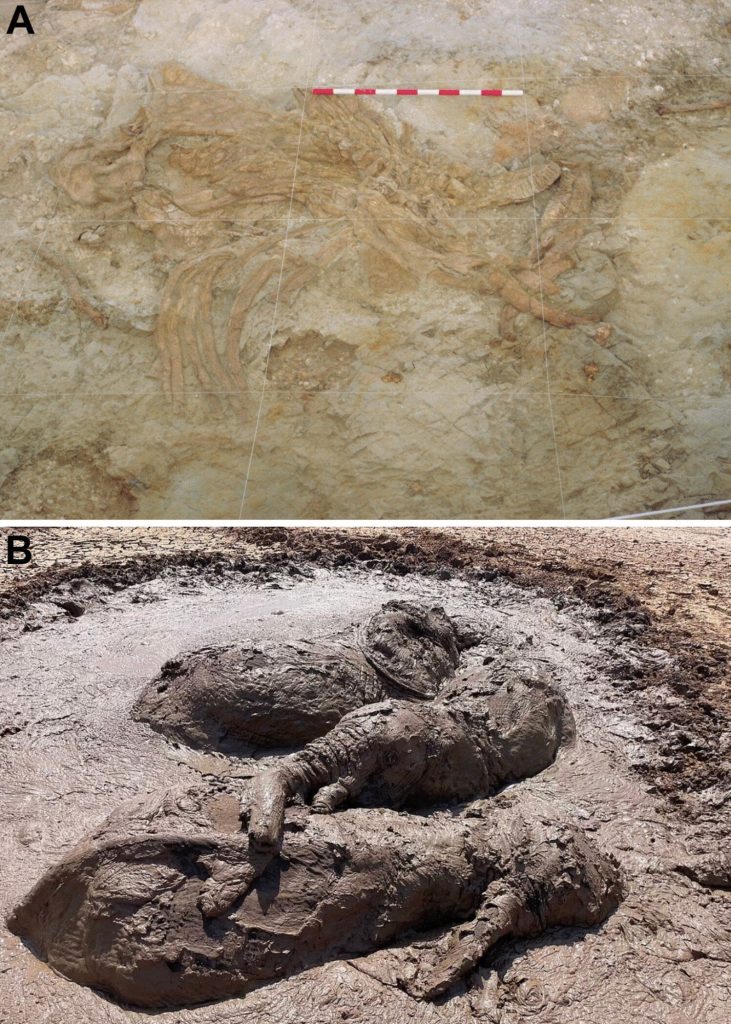A) Partial skeleton of an elephant (Mammuthus meridionalis) from Layer 5 of the upper archaeological layer at the Late Early Pleistocene site of Fuente Nueva 3. B) An adult female elephant and two calves caught in a mud trap in Kenya. Credit: Iberian Geological Journal (2024). Publication date: 10.1007/s41513-024-00241-1
Scientists from the University of Málaga have revealed in an unprecedented way that the so-called “elephant graveyard” of the Early Pleistocene archaeological site of Orce (named for the mass remains of the extinct elephant species Mammutus meridionalis) was hiding a natural trap in its shifting sands.
This study Published In Iberian Geological Journal.
The Fuente Nueva 3 (FN3) site, located on the northeastern edge of the Guadix Baza lowland (Granada), is one of the deposits of Orce that contain some of the oldest evidence of human presence in Western Europe, consisting of a 1.4 million year old assemblage of lithics (stones carved by our ancestors).
Similarly, Remains It is rich in manuports (unworked stones used as striking tools to crush bones and extract marrow, and possibly as thrown weapons to scare off hyenas) and the fossil remains of large mammals bearing human traces related to skinning, butchering and marrow processing, as well as bones bearing tooth marks made by scavenging carnivores.
Two archaeological levels
According to the study, co-led by UMA paleontology professor Pål Palmqvist and UMA geology and paleontology professor María Patrocinio Espigales, the site’s fertile soil has two distinct archaeological levels: the Lower Level (LAL) and the Upper Level (UAL).
Both layers preserve abundant skeletal remains and stone tools, but the first layer shows a higher density of workshops suggesting greater human activity in this layer, whereas the second layer preserves a greater number of remains of large herbivores, especially the extinct elephant Mammuthus meridionalis, indicating a greater involvement of the giant hyena.
Scientists have focused on the composition and sedimentology of the faunal communities preserved in these two layers, particularly Particle size in the fertile layers of both formations. The latter is a key aspect of the study, showing that in the lower layer, layers 2-3, silt and clay dominate, while in the upper layer, layer 5, fine and very fine sand dominate.
“These fine sand deposits, which were deposited near ancient lakes in this region, contain only a small amount of brine“This mixture explains why they could have acted as quicksand, trapping larger animals,” say the UMA scientists.

The study was co-led by Paul Palmqvist, professor in the Department of Palaeontology at the University of Malaga, and Maria Patrocinio Espigales, professor in the Department of Geology and Palaeontology at the University of Malaga. Courtesy of the University of Malaga
Food for Scavengers
The researchers suggest that the latter layer can be interpreted as a natural quicksand trap in which a large herbivore became trapped by the excess weight of its limbs, and the half-submerged carcasses attracted scavengers, both hyenas and humans, who fed on them and left behind stone tool assemblages and coprolites (fossilized hyena excrement) as evidence of their presence.
The new discovery, made by the UMA researchers, represents “the first time that a natural trap with these characteristics has been described in a fossil deposit of particular interest for human evolution and represents a very important milestone towards gaining more knowledge about the survival strategies of our first European ancestors, and their competition with large scavenging hyenas for these meat resources.”
Carrying out more detailed studies to distinguish between the upper and lower archaeological levels, as well as characterizing other important sites in the Orce region, such as Barranco León, which also provide evidence of human presence, are the next steps planned by the UMA’s scientific team, which also includes researchers from the Complutense University of Madrid and the University of Tarragona.
For more information:
Pål Palmqvist et al., “The Late Pleistocene Fuente Nueva-3 site (Baza depression, Guadix, southeastern Spain): a hyena toilet built over a quicksand trap for large herbivores?” Iberian Geological Journal (2024). Publication date: 10.1007/s41513-024-00241-1
Provided by
University of Malaga
Quote: Scientists discover natural quicksand traps more than one million years old in Orce’s ‘elephant graveyard’ (July 11, 2024) Retrieved July 12, 2024 from https://phys.org/news/2024-07-scientists-natural-quicksand-dated-million.html
This document is subject to copyright. It may not be reproduced without written permission, except for fair dealing for the purposes of personal study or research. The content is provided for informational purposes only.


